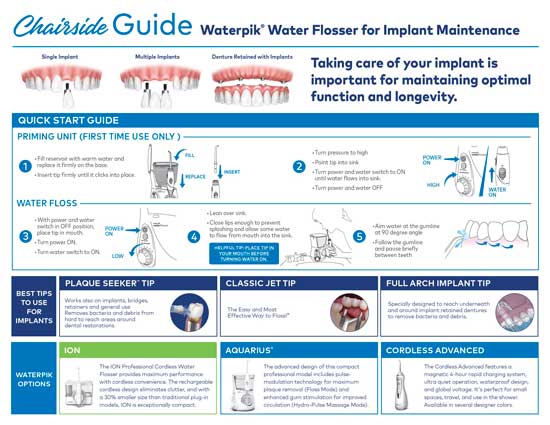Physical Address
304 North Cardinal St.
Dorchester Center, MA 02124
To clean implants with a Waterpik, use a low-pressure setting and clean around the implant carefully to remove plaque and debris while being gentle to avoid damaging the area. Waterpiks are a great tool for maintaining oral hygiene, especially for those with dental implants.
When used correctly, they can effectively remove plaque and food particles without causing harm to the implant area. However, it’s important to use the Waterpik on a low-pressure setting and to be gentle while cleaning around the implant to prevent any damage.
We will discuss the proper way to clean implants with a Waterpik and some tips for maintaining oral health with dental implants. Keep reading to find out more.

Credit: www.waterpik.com
Understanding Waterpik.
Waterpik uses a pulsating water stream to clean around implants effectively.
Efficiently removes debris, reduces plaque buildup, and promotes gum health.
When it comes to maintaining good oral hygiene, cleaning your dental implants is just as important as cleaning your natural teeth. One effective tool for cleaning implants is a Waterpik, which uses a pulsating stream of water to remove plaque and debris from hard-to-reach areas. If you’re unsure about how to clean implants with a Waterpik, this guide will walk you through the process step by step. In this section, we’ll cover the preparation necessary before using a Waterpik to clean your implants.
To ensure a successful cleaning session with your Waterpik, it’s important to gather all the necessary supplies beforehand. By having everything ready, you’ll save time and make the process more efficient. Here’s a list of what you’ll need:
| Supplies |
|---|
| Waterpik device |
| Waterpik tips (suitable for implants) |
| Mouthwash (optional) |
| Warm water |
Make sure the Waterpik tips you choose are designed specifically for cleaning implants. These specialized tips usually have a smaller size and gentler spray to effectively clean around the implants without causing any discomfort or damage. Additionally, using mouthwash in combination with warm water can provide an added level of cleanliness and freshness to your cleaning routine.
Before using a Waterpik to clean your implants, it’s essential to take some precautions to ensure a safe and effective experience. By following these precautions, you can protect your implants and the surrounding gum tissues. Here are some important measures to keep in mind:
By adhering to these precautions, you can maximize the benefits of using a Waterpik to clean your implants while minimizing any potential risks. Remember, proper cleaning techniques coupled with regular dental check-ups will ensure the longevity and health of your dental implants.
The cleaning process for implants involves using a Waterpik, a dental tool that uses a stream of water to remove plaque and debris from your teeth and gums. Using a Waterpik for cleaning implants can be an effective way to maintain proper oral hygiene and keep your implants clean and healthy. In this step-by-step guide, we will walk you through the process of using a Waterpik for cleaning implants, along with some valuable tips for effective cleaning.
Follow these simple steps to effectively clean your implants using a Waterpik:
Here are some valuable tips to enhance the effectiveness of your cleaning process:
By following this step-by-step guide and implementing these helpful tips, you can ensure a thorough and effective cleaning process for your implants using a Waterpik. Remember to maintain regular dental visits and consult with your dentist for personalized advice.

Credit: www.sarahwilmerdds.com
After cleaning your dental implants with Waterpik, it is important to follow proper post-cleaning care to maintain their hygiene and longevity.
When caring for dental implants, there are additional considerations beyond the basic cleaning process. Understanding the frequency of cleaning and the importance of consulting a dental professional is vital for maintaining the health and longevity of your implants.
It is recommended to clean your implants daily using a Waterpik. This helps to remove plaque and food particles that can lead to bacterial buildup and potential gum irritation.
Regular visits to your dental professional are essential for monitoring the health of your implants and ensuring proper maintenance. They can provide personalized advice on cleaning techniques and identify any potential issues early on, ultimately preventing complications.
When it comes to cleaning implants with a Waterpik, it’s important to be aware of common mistakes that people often make. By avoiding these missteps, you can ensure that you are effectively cleaning your implants and maintaining optimal oral hygiene. Here are some common mistakes to steer clear of:
Using a Waterpik with the wrong technique can result in ineffective cleaning. It’s crucial to hold the Waterpik at a 90-degree angle to the gumline while using a low to medium pressure setting. This helps to gently remove plaque and debris without causing damage to the implants or surrounding tissues. Avoid angling the Waterpik directly onto the implants, as this can lead to unnecessary pressure and potential harm.
Neglecting certain areas while using a Waterpik can compromise the overall effectiveness of the cleaning process. It’s essential to target all hard-to-reach areas around the implants, including the spaces between the implants and adjacent teeth. This ensures that no debris or bacteria is left behind, helping to prevent potential issues such as gum inflammation and infection.

Credit: www.nuviasmiles.com
Water flossing with a Waterpik is an effective and convenient way to clean implants. Its pulsating water stream reaches areas that traditional flossing may miss, resulting in improved oral hygiene. Regular use of the Waterpik can help prevent plaque buildup and reduce the risk of gum disease.
Incorporating this easy-to-use device into your oral care routine can contribute to the overall health and longevity of your implants.